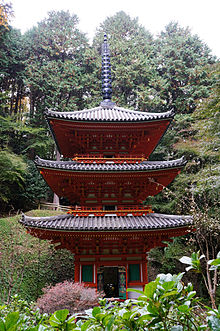Goose-ji
The goose-ji ( Japanese 岩 船 寺 ) is a temple in the mountains on the eastern edge of the city of Kizugawa , Kyoto Prefecture . The temple belongs to the Shingon direction of Buddhism .
history
According to their own tradition, the temple goes back to a request of the emperor Shōmu , according to which the priest Gyōki built a prayer hall in 729, which Amidadō ( 阿 弥陀 堂 ) built. In 806 Kūkai , together with the daughter of his older sister Chisen ( 知 泉 ), used the complex as 蒲 頂 堂 and built the Shin'on-ji ( 新 恩 寺 ). On the instructions of Emperor Saga , the baptism of his son, who later became Emperor Nimmyo, was carried out there. After further construction, the temple received its current name in 813.
The Empress Tachibana no Kachiko ( 橘 嘉智子 ) also donated 10 Chō to the temple with rice fields and forests of 360 Chō. In its heyday, the temple grounds were 36 chō and had 39 sub-temples. In 1221 the temple was set on fire by soldiers and could only be rebuilt on a modest scale after 1600.
The attachment
In front of the temple gate on the left there is a stone tub in the shape of a boat, which was used by the monks for bathing in cold water and which may be the name of the temple. Behind the gate on the left there is a stone stupa, a Gorintō from the Kamakura period , which is registered as an important cultural asset (◎). Behind it is a flat figure of a Fudō Myōō made of granite and a stone Buddha in a niche ( 石 造 仏 龕 , sekizō butsugan ; ◎) - according to the inscription - from 1312 and a 13-story stone pagoda (◎).
On the right is the refectory and behind it the main hall. A seated wooden Amida Buddha (◎) is venerated in the main hall. An inscription indicates that the figure was completed in 946, possibly around the time the temple was founded. The seated Buddha is unusually tall at 2.85 m. Next to the Buddha is a shrine with a small joint Bosatsu ( 普賢 菩薩 ; ◎) from the Heian period . The altar area is protected by the Four Kings of Heaven from 1293.
A three-story, 17.56 m high pagoda (◎) from 1442 stands on a hill in the temple area. Inside, the eight fathers of Shingon Buddhism are shown in color behind the altar. Two well-known devil masks from the Heian and Kamakura periods and two bells ( 唐 金鈴 , Tōkinrei ) are also kept there.
The hill behind the temple is called Kaifukiyama ( 貝 吹 山 ). At the top there is a rock with an approximately 3 × 3 m flat surface called the Kaifuki rock. This is where the monks gathered for special occasions to blow funnel-shaped clams. That was the kaifuki .
literature
- Hamashima, Masaji. Goose-ji . In: Joruri-ji, Gansen-ji, Kaijūsen-ji. Yamato no furudera 7. Iwanami Shoten, 1981.
Web links
Individual evidence
- ↑ a b c Yamamoto, Jirō: Gansen-ji . In: Kyoto-fu no rekishi sampo (ge). Yamakawa Shuppan, 1999. ISBN 978-4-634-29660-2 .
- ↑ A Chō ( 町 ) has an area of almost one hectare.
Coordinates: 34 ° 43 ′ 13 ″ N , 135 ° 53 ′ 9 ″ E


